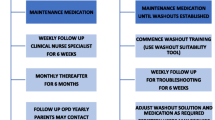Abstract
Purpose
Obstetric patients frequently experience changes in bowel function, throughout pregnancy and into the postpartum period. Little is known regarding the timing and consistency of bowel movements immediately postpartum. The primary aim of this study was to characterize the timing and consistency of the first bowel movement after obstetric delivery in a racially diverse population at an academic medical center.
Methods
Patients were approached on the day of delivery. Patients received a data collection survey to record the date and consistency of their first bowel movement. Consistency was assessed using the Bristol Stool Form Scale.
Results
One hundred and sixty-nine patients were enrolled and 101 completed surveys were returned, for a response rate of 59 %. The average number of days to first bowel movement was 1.55 versus 3.38 (p < 0.01), for vaginal delivery and cesarean section, respectively. Univariate analysis revealed cesarean delivery (+1.79 days, p < 0.01) and breastfeeding (−0.64 days, p = 0.01) as independent factors affecting the timing of the first bowel movement.
Conclusions
Both route of delivery and breastfeeding status may affect timing and consistency of the first bowel movement after obstetric delivery.

Similar content being viewed by others
References
Jewell D, Young G (2001) Interventions for treating constipation in pregnancy. Cochrane Database Syst Rev (2):Article No CD001142. doi:10.1002/14651858.CD001142
Anderson AS (1984) Constipation during pregnancy: incidence and methods used in its treatment in a group of Cambridgeshire women. Health Visit 57:363–364
Anderson AS, Lean ME (1986) Dietary intake in pregnancy. A comparison between 49 Cambridgeshire women and current recommended intake. Hum Nutr Appl Nutr 40A:40–48
Greenhalf JO, Leonard HSD (1973) Laxatives in the treatment of constipation in pregnant and breast-feeding mothers. Practitioner 210:259–263
Marshall K, Thompson KA, Walsh DM, Baxter GD (1998) Incidence of urinary incontinence and constipation during pregnancy and postpartum: survey of current findings at the Rotunda Lying-in Hospital. Br J Obstet Gynaecol 105:400–402
Derbyshire EJ, Davies J, Detmar P (2007) Changes in bowel function: pregnancy and the puerperium. Dig Dis Sci 52:324–328
van Brummen HJ, Bruinse HW, van de Pol G, Heintz AP, van der Haart CH (2006) Defecatory symptoms during and after the first pregnancy: prevalences and associated factors. Int Urogynecol J 17:224–230
Bradley CS, Kennedy CM, Turcea AM, Rao SSC, Nygaard IE (2007) Constipation in pregnancy. Obstet Gynecol 110:1351–1357
Sun SX, Dibonaventure M, Purayidathil FW, Wagner JS, Dabbous O, Mody R (2011) Impact of chronic constipation on health-related quality of life, work productivity and healthcare resource use: an analysis of the National Health and Wellness Survey. Dig Dis Sci 56(9):2688–2695
Wald A, Sigurdsson L (2011) Quality of life in children and adults with constipation. Best Pract Res Clin Gastroenterol 25(1):19–27
Scott LD, Lester R, Van Thiel DH, Wald A (1983) Pregnancy related changes in small intestinal myoelectrical activity in the rat. Gastroenterology 84:301–305
Ryan JP, Bhojwani A (1986) Colonic transit in rats: effect of ovariectomy, sex steroid hormones, and pregnancy. Am J Physiol 251:G46–G50
Wald A, VanThiel DH, Hoechstetter L et al (1981) Gastrointestinal transit: the effect of the menstrual cycle. Gastroenterology 80:1497–1506
Wald A, VanThiel DH, Hoechstetter L et al (1982) Effect of pregnancy on the gastrointestinal transit. Dig Dis Sci 27:1015–1018
Soriano D, Dulitzki M, Kridar N, Barkai G, Mashiach S, Seidman DS (1996) Early oral feeding after cesarean delivery. Obstet Gynecol 87:1006–1008
Patolia D, Hilljard R, Tby E, Baker B (2001) Early feeding after cesarean: a randomized trial. Obstet Gynecol 98:113–116
Adupa D, Wandabwa J, Kiondo P (2003) A randomized controlled trial of early initiation of oral feeding after cesarean delivery in Mulago Hospital. East Afr Med J 80:345–350
Kafali H, Duvan C, Gozdemir E, Simavli S, Onaran Y, Keskin E (2010) Influence of gum chewing on postoperative bowel activity after cesarean section. Gynecol Obstet Invest 69:84–87
Ohlsson B (2007) Bowel habits in women during pregnancy, breast feeding and after breast feeding. J Clin Gastroenterol 41:224–225
Lewis SJ, Heaton KW (1997) Stool form scale as a useful guide to intestinal transit time. Scand J Gastroenterol 32:920–924
Anderson A, Whichelow M (1985) Constipation during pregnancy: dietary fibre intake and the effect of fibre supplementation. Hum Nutr Appl Nutr 39A:202–207
Tarr M, Klenov V, Tanzy M, Rivard C et al (2012) Perioperative bowel habits of women undergoing gynecologic surgery: a pilot study. Female Pelvic Reconstr Surg 18:153–157
Conflict of interest
None of the authors have a conflict of interest.
Author information
Authors and Affiliations
Corresponding author
Rights and permissions
About this article
Cite this article
Graziano, S., Murphy, D., Braginsky, L. et al. Assessment of bowel function in the peripartum period. Arch Gynecol Obstet 289, 23–27 (2014). https://doi.org/10.1007/s00404-013-2914-9
Received:
Accepted:
Published:
Issue Date:
DOI: https://doi.org/10.1007/s00404-013-2914-9




